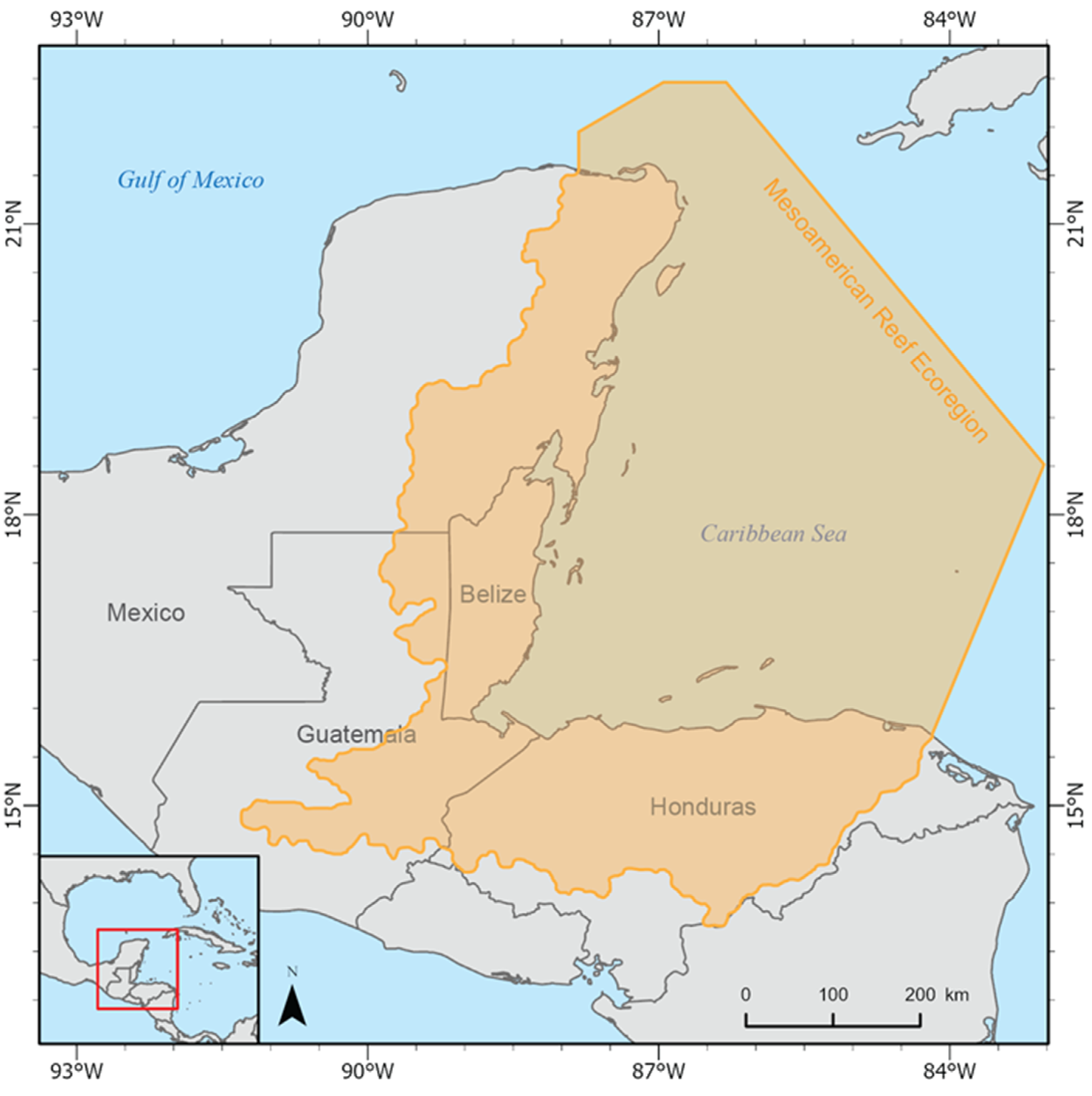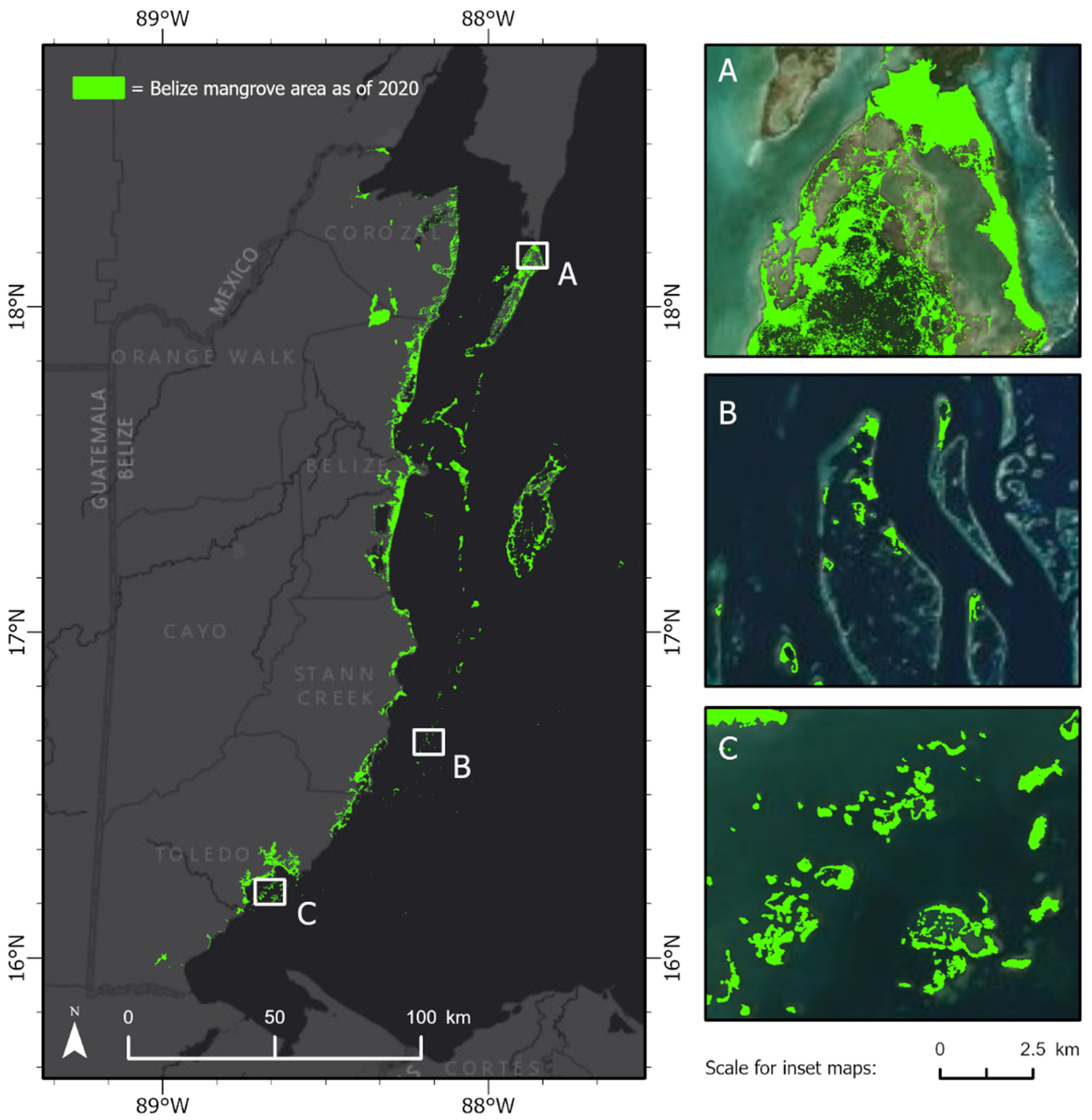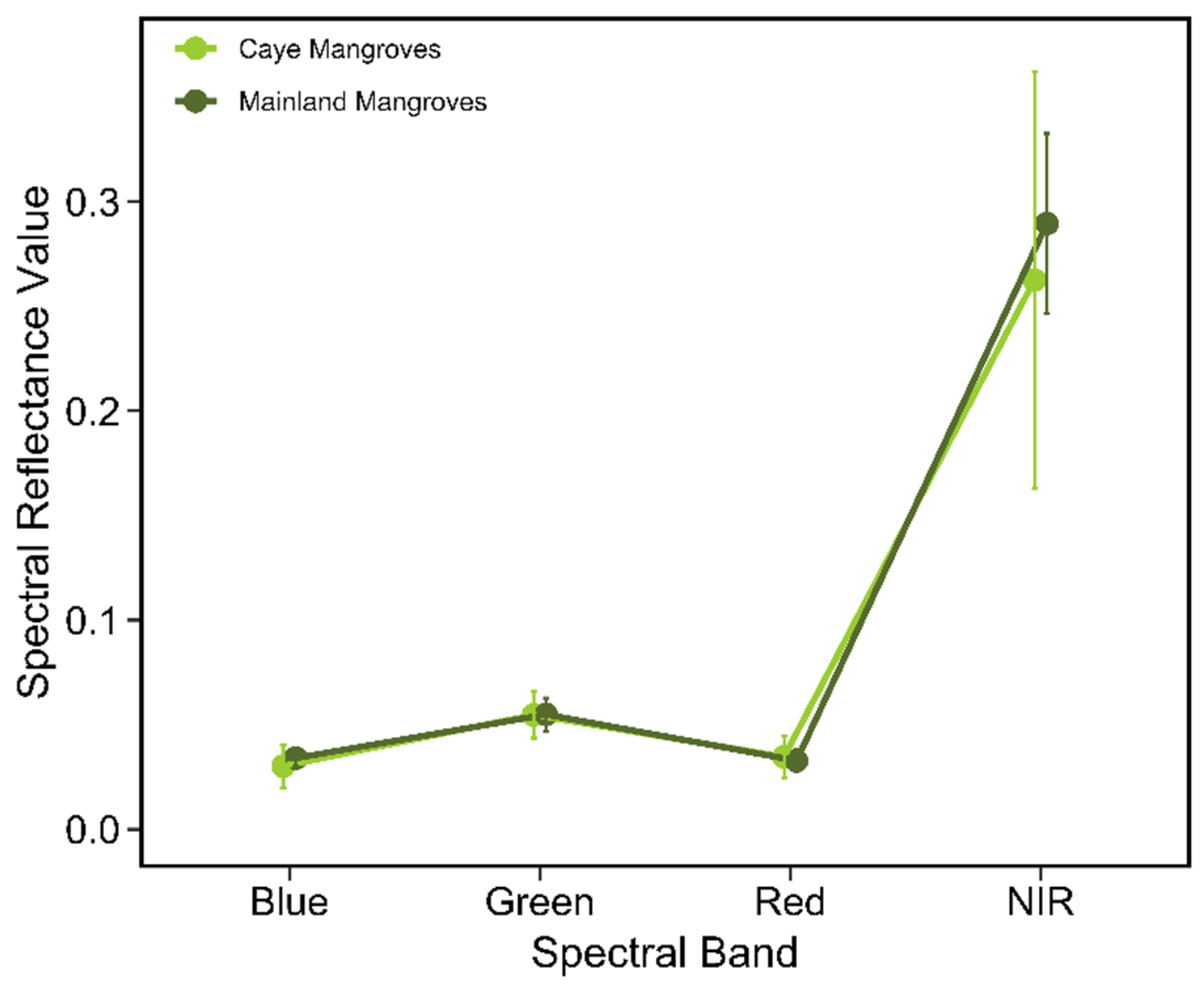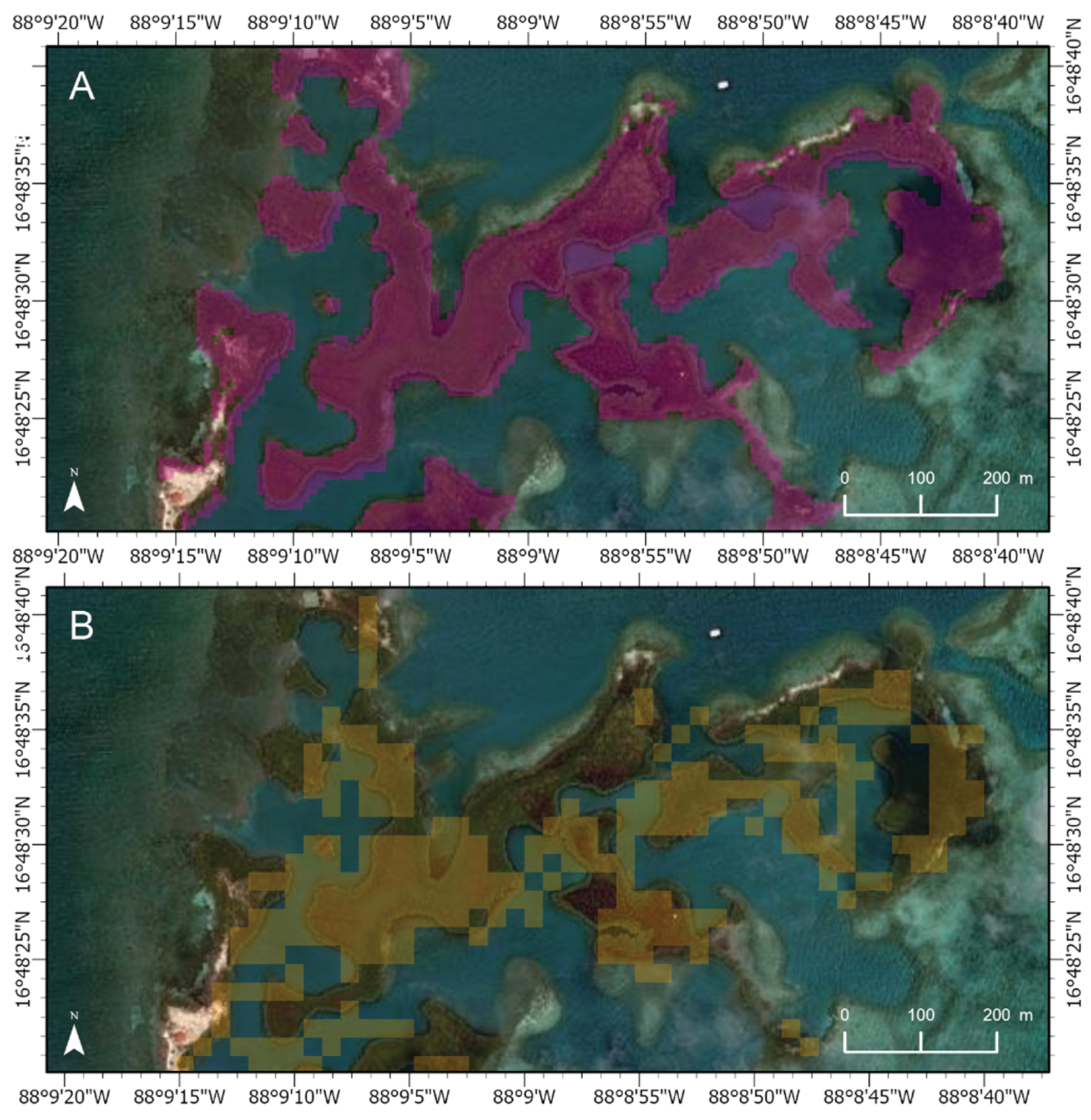Mapping National Mangrove Cover for Belize Using Google Earth Engine and Sentinel-2 Imagery
Abstract
1. Introduction
2. Materials and Methods
2.1. Study Area
2.2. Field Observations
2.3. Image Preprocessing
2.4. Image Classification
2.5. Accuracy Assessment
3. Results
4. Discussion
5. Conclusions
Supplementary Materials
Author Contributions
Funding
Institutional Review Board Statement
Informed Consent Statement
Data Availability Statement
Acknowledgments
Conflicts of Interest
References
- Tomlinson, P.B. The Botany of Mangroves; Cambridge University Press: Cambridge, UK, 1994. [Google Scholar]
- Adams, A.J.; Murchie, K.J. Recreational fisheries as conservation tools for mangrove habitats. Am. Fish. Sci. Symp. 2015, 83, 43–56. [Google Scholar]
- Nagelkerken, I.; Roberts, C.M.; van der Velde, G.; Dorenbosch, M.; van Riel, M.C.; de la Cocheret, M.; Nienhuis, P.H. How important are mangroves and seagrass beds for coral-reef fish? The nursery hypothesis tested on an island scale. Mar. Ecol. Prog. Ser. 2002, 244, 299–305. [Google Scholar] [CrossRef]
- McFadden, T.N.; Kauffman, J.B.; Bhomia, R.K. Effects of nesting waterbirds on nutrient levels in mangroves, Gulf of Fonseca, Honduras. Wetl. Ecol. Manag. 2016, 24, 217–229. [Google Scholar] [CrossRef]
- Menéndez, P.; Iñigo, J.L.; Torres-Ortega, S.; Narayan, S.; Beck, M.W. The Global Flood Protection Benefits of Mangroves. Sci. Rep. 2020, 10, 4404. [Google Scholar] [CrossRef] [PubMed]
- Ewel, K.C.; Twilley, R.R.; Ong, J.E. Different kinds of mangrove forests provide different goods and services. Glob. Ecol. Biogeogr. Lett. 1998, 7, 83–94. [Google Scholar] [CrossRef]
- Krauss, K.W.; Cormier, N.; Osland, M.J.; Kirwan, M.L.; Stagg, C.L.; Nestlerode, J.A.; Russell, M.J.; Form, A.S.; Spivak, A.C.; Dantin, D.D.; et al. Created mangrove wetlands store belowground carbon and surface elevation change enables them to adjust to sea-level rise. Sci. Rep. 2017, 7, 1030. [Google Scholar] [CrossRef] [PubMed]
- Lovelock, C.E.; Duarte, C.M. Dimensions of Blue Carbon and emerging perspectives. Biol. Lett. 2019, 15, 20180781. [Google Scholar] [CrossRef]
- Cissell, J.R.; Steinberg, M.K. Human Landscape Modification in Placencia, Stann Creek District, Belize: Possible Implications for Crocodile Hybridization. J. Lat. Am. Geogr. 2020, 19, 218–242. [Google Scholar] [CrossRef]
- Spalding, M.; Kainuma, M.; Collins, L. World Atlas of Mangroves; Earthscan: Washington, DC, USA, 2010. [Google Scholar]
- Steinberg, M.K. A nationwide assessment of threats to bonefish, tarpon, and permit stocks and habitat in Belize. Environ. Biol. Fishes 2015, 98, 2277–2285. [Google Scholar] [CrossRef]
- Sweetman, B.M.; Cissell, J.R.; Rhine, S.; Steinberg, M.K. Land Cover Changes on Ambergris Caye, Belize: A Case Study of Unregulated Tourism Development. Prof. Geogr. 2019, 71, 123–234. [Google Scholar] [CrossRef]
- Simpson, L.T.; Canty SW, J.; Cissell, J.R.; Steinberg, M.K.; Cherry, J.A.; Feller, I.C. Bird Rookeries and Nutrient Over-Enrichment as Potential Accelerants of Mangrove Cay Decline in Belize. Oecologia, In Revision.
- Canty SW, J.; Preziosi, R.F.; Rowntree, J.K. Dichotomy of mangrove management: A review of research and policy in the Mesoamerican reef region. Ocean Coast. Manag. 2018, 157, 40–49. [Google Scholar] [CrossRef]
- Government of Belize. 2016. Nationally Determined Contribution under the United Nations Framework Convention on Climate Change. Bel-Mopan, Belize: Government of Belize. Available online: https://www4.unfccc.int/sites/ndcstaging/PublishedDocuments/Belize%20First/BELIZE%27s%20%20NDC.pdf (accessed on 23 February 2021).
- Kumagi, J.A.; Costa, M.T.; Ezcurra, E.; Aburto-Oropeza, O. Prioritizing mangrove conservation across Mexico to facilitate 2020 NDC ambition. Ambio 2020, 49, 1992–2002. [Google Scholar] [CrossRef]
- The Blue Carbon Initiative. 2020. Blue Carbon and Nationally Determined Contributions. Arlington, Virginia: Conservation International, Intergovernmen-tal Oceanographic Commission of UNESCO, International Union for Conservation of Nature. 2020. Available online: https://static1.squarespace.com/static/5c7463aaa9ab95163e8c3c2e/t/5eebd563fc0c543da1ea69ab/1592513897734/Blue_Carbon_NDC_Guidelines_spread.pdf (accessed on 23 February 2021).
- Rivas, A.B.; González, C.; Canty, S.; Rodríguez Olivet, C.; Flamenco, X.; González, M.J.; Escobedo, M. Regional Strategy for Mangrove Management, Conservation, Restoration and Monitoring in the Mesoamerican Reef 2020–2025; Mesoamerican Reef Fund: Guatemala City, Guatemala, 2020. [Google Scholar] [CrossRef]
- Cherrington, E.A.; Ek, E.; Cho, P.; Howell, B.F.; Hernandez, B.E.; Anderson, E.R.; Flores, A.I.; Garcia, B.C.; Sempris, E.; Irwin, D.E. Forest Cover and Deforestation in Belize: 1980–2010; Water Center for the Humid Tropics of Latin America and the Caribbean (CATHALAC): Panama City, Panama, 2010. [Google Scholar]
- Delgado, F.J.; Cherrington, E.A.; Griffin, R.; Hernandez, B.E.; Anderson, E.R.; Flores Cordova, A.I.; Muench, R.; Markert, K.N.; Adams, E.C.; Limaye, A.S.; et al. Use of Earth Observation data for assessing change in mangrove cover across the Belize Barrier Reef Reserve System-World Heritage Site. In Proceedings of the Conference abstract for American Geophysical Union Fall Meeting, San Francisco, CA, USA, 9–13 December 2019. [Google Scholar]
- Valderrama Landeros, L.H.; Rodriguez Zúñiga, M.T.; Troche Souza, C.; Velázquez Salazar, S.; Villeda Chávez, E.; Alcántara Maya, J.A.; Vázquez Balderas, B.; Cruz López, M.I.; Ressl, R. Manglares de México: Actualización y Exploración de los Datos del Sistema de Monitoreo 1970/1980-2015; Comisión Nacional para el Conocimiento y Uso de la Biodiversidad (CONABIO): Mexico City, México, 2017. [Google Scholar]
- Bunting, P.; Rosenqvist, A.; Lucas, R.M.; Rebelo, L.M.; Hilarides, L.; Thomas, N.; Hardy, A.; Itoh, T.; Shimada, M.; Finlayson, C.M. The Global Mangrove Watch—A new 2010 global baseline of mangrove extent. Remote Sens. 2018, 10, 1669. [Google Scholar] [CrossRef]
- Gorelick, N.; Hancher, M.; Dixon, M.; Ilyushchenko, S.; Thau, D.; Moore, R. Google Earth Engine: Planetary-scale geospatial analysis for everyone. Remote Sens. Environ. 2017, 202, 18–27. [Google Scholar] [CrossRef]
- Kumar, L.; Mutanga, O. Google Earth Engine Applications since Inception: Usage, Trends, and Potential. Remote Sens. 2018, 10, 1509. [Google Scholar] [CrossRef]
- Hu, L.; Nan, X.; Liang, J.; Li, Z.; Chen, L.; Zhao, F. Advancing the Mapping of Mangrove Forests at National-Scale Using Sentinel-1 and Sentinel-2 Time-Series Data with Google Earth Engine: A Case Study in China. Remote Sens. 2020, 12, 3120. [Google Scholar] [CrossRef]
- Maung, W.S.; Sasaki, J. Assessing the Natural Recovery of Mangroves after Human Disturbance Using Neural Network Classification and Sentinel-2 Imagery in Wunbaik Mangrove Forest, Myanmar. Remote Sens. 2021, 13, 52. [Google Scholar] [CrossRef]
- Yancho JM, M.; Jones, T.G.; Gandhi, S.R.; Ferster, C.; Lin, A.; Glass, L. The Google Earth Engine Mangrove Mapping Methodology (GEEMMM). Remote Sens. 2020, 12, 3578. [Google Scholar] [CrossRef]
- Chen, N. Mapping mangrove in Dongzhaigang, China using Sentinel-2 imagery. J. Appl. Remote Sens. 2020, 14, 014508. [Google Scholar] [CrossRef]
- Elmahdy, S.I.; Ali, T.A.; Mohamed, M.M.; Howari, F.M.; Abouleish, M.; Simonet, D. Spatiotemporal Mapping and Monitoring of Mangrove Forests Changes From 1990 to 2019 in the Northern Emirates, UAE Using Random Forest, Kernel Logistic Regression and Naïve Bayes Tree Models. Front. Environ. Sci. 2020, 8, 102. [Google Scholar] [CrossRef]
- Li, H.; Jia, M.; Zhang, R.; Ren, Y.; Wen, X. Incorporating the Plant Phenological Trajectory into Mangrove Species Mapping with Dense Time Series Sentinel-2 Imagery and the Google Earth Engine Platform. Remote Sens. 2019, 11, 2479. [Google Scholar] [CrossRef]
- Pimple, U.; Simonetti, D.; Sitthi, A.; Punhkul, S.; Leadprathom, K.; Skupek, H.; Som-ard, J.; Gond, V.; Towprayoon, S. Google Earth Engine Based Three Decadal Landsat Imagery Analysis for Mapping of Mangrove Forests and Its Surroundings in the Trat Province of Thailand. J. Comput. Commun. 2018, 6, 247–264. [Google Scholar] [CrossRef]
- Cissell, J.R.; Delgado, A.M.; Sweetman, B.M.; Steinberg, M.K. Monitoring mangrove forest dynamics in Campeche, Mexico, using Landsat satellite data. Remote Sens. Appl. Soc. Environ. 2018, 9, 60–68. [Google Scholar] [CrossRef]
- Jones, T.G.; Ratsimba, H.R.; Ravaoarinorotsihoarana, L.; Cripps, G.; Bey, A. Ecological variability and carbon stock estimates of mangrove ecosystems in Northwestern Madagascar. Forests 2014, 5, 177–205. [Google Scholar] [CrossRef]
- McFeeters, S.K. The use of the Normalized Difference Water Index (NDWI) in the delineation of open water features. Int. J. Remote Sens. 1996, 17, 1425–1432. [Google Scholar] [CrossRef]
- Shi, T.; Liu, J.; Hu, Z.; Liu, H.; Wang, J.; Wu, G. New spectral metrics for mangrove forest identification. Remote Sens. Lett. 2016, 7, 885–894. [Google Scholar] [CrossRef]
- Jensen, J.R. Introductory Digital Image Processing: A Remote Sensing Perspective, 4th ed.; Prentice Hall: Upper Saddle River, NJ, USA, 2015. [Google Scholar]
- Congalton, R.G.; Green, K. Assessing the Accuracy of Remotely Sensed data: Principles and Practices, 2nd ed.; CRC Press: Boca Raton, FL, USA, 2008. [Google Scholar]
- Feller, I.C.; Friess, D.A.; Krauss, K.W.; Lewis, R.R. The state of the world’s mangroves in the 21st century under climate change. Hydrobiologia 2017, 803, 1–12. [Google Scholar] [CrossRef]
- Zaldívar-Jiménez, A.; Ladrón-de-Guevara-Porras, P.; Pérez-Ceballos, R.; Díaz-Mondragón, S.; Rosado-Solórzano, R. US-Mexico joint Gulf of Mexico large marine ecosystem based assessment and management: Experience in community involvement and mangrove wetland restoration in Terminos Lagoon, Mexico. Environ. Dev. 2017, 22, 206–213. [Google Scholar] [CrossRef]
- Friess, D.A.; Rogers, K.; Lovelock, C.E.; Krauss, K.W.; Hamilton, S.E.; Lee, S.Y.; Lucas, R.; Primavera, J.; Rajkaran, A.; Shi, S. The state of the world’s mangrove forests: Past, present, and future. Annu. Rev. Environ. Resour. 2019, 44, 89–115. [Google Scholar] [CrossRef]
- Friess, D.A.; Yando, E.S.; Abuchala GM, O.; Adams, J.B.; Cannicci, S.; Canty SW, J.; Cavanaugh, K.C.; Connolly, R.M.; Cormier, N.; Dahdouh-Guebas, F.; et al. Mangroves give cause for conservation optimism, for now. Curr. Biol. 2020, 30, R135–R158. [Google Scholar] [CrossRef]
- Ward, R.D.; Friess, D.A.; Day, R.H.; Mackenzie, R.A. Impacts of climate change on mangrove ecosystems: A region by region overview. Ecosyst. Health Sustain. 2016, 2, e01211. [Google Scholar] [CrossRef]
- Curnick, D.J.; Petteroelli, N.; Aldrie Amir, A.; Balke, T.; Barbier, E.B.; Crooks, S.; Dahdouh-Guebas, F.; Duncan, C.; Endsor, C.; Friess, D.A.; et al. The value of small mangrove patches. Science 2019, 363, 239. [Google Scholar]
- Kuenzer, C.; Bluemel, A.; Gebhart, S.; Quoc, T.V.; Dech, S. Remote Sensing of Mangrove Ecosystems: A Review. Remote Sens. 2011, 3, 879–928. [Google Scholar] [CrossRef]
- Pham, T.D.; Yokoya, N.; Bui, D.T.; Yoshino, K.; Friess, D.A. Remote Sensing Approaches for Monitoring Mangrove Species, Structure, and Biomass: Opportunities and Challenges. Remote Sens. 2019, 11, 230. [Google Scholar] [CrossRef]




| Accuracy Assessment Error Matrix | ||||
|---|---|---|---|---|
| Reference Data | ||||
| Mangrove | Non-Mangrove | Row Total | ||
| Finalized mangrove map | Mangrove | 960 | 40 | 1000 |
| Non-mangrove | 34 | 966 | 1000 | |
| Column total | 994 | 1006 | 2000 | |
| Overall accuracy: | 96.30% | |||
| Kappa coefficient: | 92.60% | |||
| Mangrove commission error: | 4.00% | |||
| Mangrove omission error: | 3.42% | |||
Publisher’s Note: MDPI stays neutral with regard to jurisdictional claims in published maps and institutional affiliations. |
© 2021 by the authors. Licensee MDPI, Basel, Switzerland. This article is an open access article distributed under the terms and conditions of the Creative Commons Attribution (CC BY) license (https://creativecommons.org/licenses/by/4.0/).
Share and Cite
Cissell, J.R.; Canty, S.W.J.; Steinberg, M.K.; Simpson, L.T. Mapping National Mangrove Cover for Belize Using Google Earth Engine and Sentinel-2 Imagery. Appl. Sci. 2021, 11, 4258. https://doi.org/10.3390/app11094258
Cissell JR, Canty SWJ, Steinberg MK, Simpson LT. Mapping National Mangrove Cover for Belize Using Google Earth Engine and Sentinel-2 Imagery. Applied Sciences. 2021; 11(9):4258. https://doi.org/10.3390/app11094258
Chicago/Turabian StyleCissell, Jordan R., Steven W. J. Canty, Michael K. Steinberg, and Loraé T. Simpson. 2021. "Mapping National Mangrove Cover for Belize Using Google Earth Engine and Sentinel-2 Imagery" Applied Sciences 11, no. 9: 4258. https://doi.org/10.3390/app11094258
APA StyleCissell, J. R., Canty, S. W. J., Steinberg, M. K., & Simpson, L. T. (2021). Mapping National Mangrove Cover for Belize Using Google Earth Engine and Sentinel-2 Imagery. Applied Sciences, 11(9), 4258. https://doi.org/10.3390/app11094258





